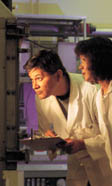 Waiting
to exhale "Trying to pinpoint which of the 4,000 compounds in cigarettes cause cancer is, to me, hopeless," says Witschi. "Humans don't consume those compounds separately. They consume them in cigarette smoke." In his Toxic Pollutants Health Research lab, mice were exposed to secondhand smoke six hours a day, five days a week for five months - "roughly the way workers in industry would encounter secondhand smoke," says Witschi. Researchers used unlabeled research cigarettes from the Tobacco Research Institute in Lexington, Kentucky. "They contain no additives," says Witschi. "A friend who tried one said they had no flavor. So the cigarettes are not pleasant for smokers but give us the unflavored smoke we need." The experimental mice were kept in a smoking environment for five months, then placed in clean air for four more months. The clean air interval was designed to mimic what happens to people who smoke but then quit. As expected, the mice developed multiple lung tumors. Voila! The cause-and-effect link between secondhand smoke and lung cancer was established.
Home |
Table of Contents |
To our Readers |
Building on Basics UC Davis Health System | © 2000, 2001, 2002 UC Regents. All rights reserved. |
Staff research associates Julian Recendez, left and Imelda Espiritu check settings for the smoke inhalation machine. |

